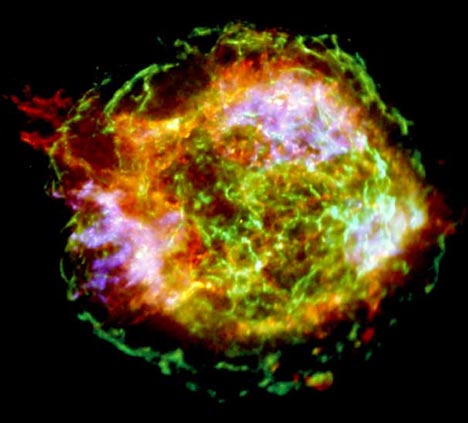Biting the hand that feeds IT
Original URL: http://www.theregister.co.uk/2004/08/26/stunning_supernova/
NASA has released a stunning new picture of Cassiopeia A, a supernova remnant. The image, made at the Chandra X-Ray Observatory contains nearly 200 times as much data as the first image made at the facility, five years ago.
NASA scientists say that the picture, which is the result of combining a million one-second observations of the remnant, shows that this supernova explosion was far more complicated than previously thought.
Martin Laming of the Naval Research Laboratory, Washington said that the observation is the most detailed ever made of an exploded star. "It is a gold mine of data that astronomers will be panning through for years to come," he said.
Cassiopeia A has been studied intensely ever since the first images were sent back by Chandra fives year ago. The explosion left a faint neutron star at the center of the remnant, but unlike the rapidly rotating neutron star in the Crab Nebula, Cassiopeia's star is quiet and faint.

The picture revealed jet-like structures extending about ten light years from the centre of the remnant. X-ray spectra of these jets indicated that they are rich in silicon, but poor in iron. The image also reveals gas clouds extremely rich in iron that have remained nearly pure since the explosion was detected: they run nearly perpendicular to the silicon jets.
This suggests that the star exploded for reasons other than a massive outpouring of gas, as that would have come from the iron rich centre of the star, the researchers say. Instead, they hypothesise that the explosion itself produced high speed jets similar to the gamma ray bursts produced by hypernovae, albeit at much lower energies.
Una Hwang of NASA's Goddard Space Flight Center, who led the research, noted: "The presence of the bipolar jets suggests that jets could be more common in relatively normal supernova explosions than supposed by astronomers." ®
NASA green lights robotic Hubble fix (http://www.theregister.co.uk/2004/08/11/nasa_saves_hubble/)
NASA splashes out on shiny supercomputer (http://www.theregister.co.uk/2004/07/28/nasa_supercomputer/)
Astronomers uncover mystery at galactic core (http://www.theregister.co.uk/2004/06/28/hot_plasma_xrays/)
© Copyright 2004